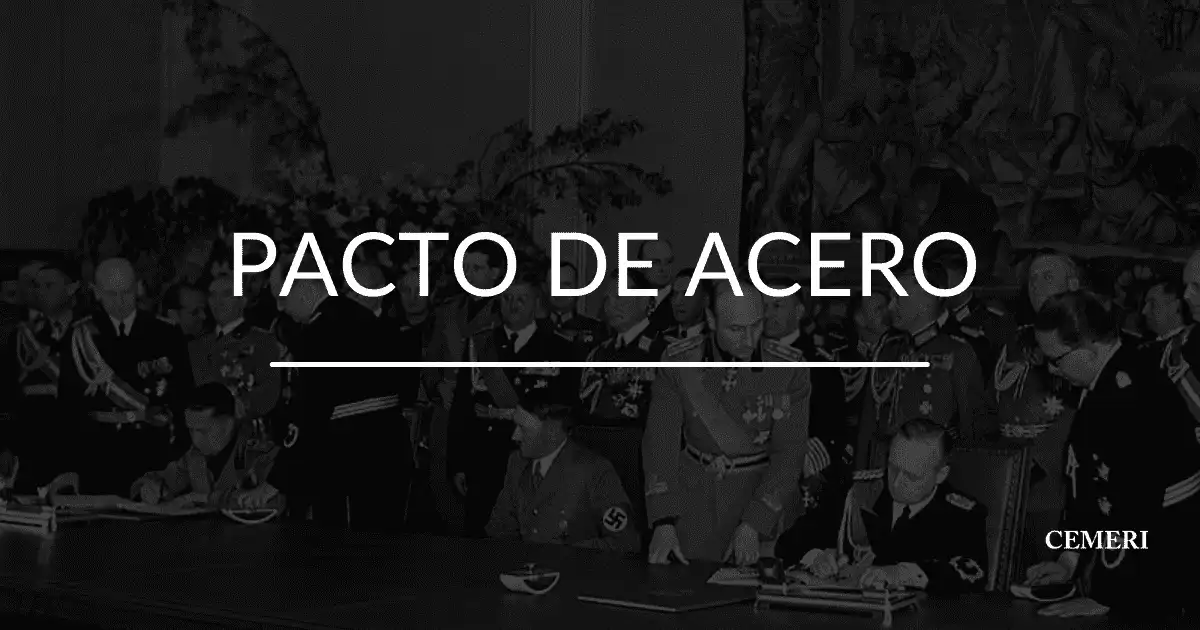Encyclopedia
Marco Olivera
What is the Pact of Steel?
- Military and political alliance between Nazi Germany and Fascist Italy. It promised that no nation would seek a separate peace or armistice.

The Pact of Steel, formally known as the German-Italy Pact of Friendship and Alliance, was a military and political alliance between Nazi Germany and Fascist Italy pledging to aid the other in the event of war with another power and promising that neither would seek a separate peace or armistice.
The Pact was signed on May 22, 1939 by the foreign ministers Galeazzo Ciano of Italy and Joachim von Ribbentrop of Germany.
Name's origin
Mussolini coined the name "Pact of Steel" (he also came up with the metaphor of an "axis" linking Rome and Berlin) after reconsidering his first choice, "Pact of Blood," to describe this historic agreement with Germany. The Duce saw this association not only as a defensive alliance, protection against the Western democracies, with which he anticipated the war, but also as a source of support for his undertaking in the Balkans.
Both sides were fearful and mistrustful of the other, only superficially sharing their forward-looking plans. The result was that both Italy and Germany, instead of acting in unison, would often "react" to the other's hasty military action. In September 1940, the Pact of Steel would become the Tripartite Pact, with Japan forming the third constituent of the triad and becoming the Axis powers facing the Allies led by the United States, the Soviet Union, and the United Kingdom.
The Pact of Steel between Germany and Italy
The King of Italy and Albania, the Emperor of Ethiopia and the Chancellor of the German Reich considered the moment to confirm, through a solemn pact, the close ties of friendship and solidarity that exist between Fascist Italy and National Socialist Germany. Considering that, with the common borders definitively fixed, a secure base for reciprocal assistance and support was created between Italy and Germany, the two governments reconfirm the policy that was previously agreed upon between them in its foundations and in its objectives and that has resulted highly profitable, both for the development of the interests of both countries and for the maintenance of peace in Europe.
The Italian people and the German people, intimately united by the deep affinity of their conceptions of life and by the total solidarity of their interests, were determined to work in the future, side by side and joining forces, for the security of their space. vital and for the maintenance of peace. In a troubled world, Italy and Germany intend, on this path marked by history, to fulfill their mission of securing the foundations of European civilization. To fix these principles by means of a pact, they have designated their plenipotentiaries: By the King of Italy and Albania, Emperor of Ethiopia, the Minister of Foreign Affairs, Count Galeazzo Ciano de Cortellazzo; By German Reich Chancellor, Foreign Minister Joachim von Ribbentrop.
Who, having exchanged their full powers, found to be in good and due form, have agreed on the following articles:
Article 1: The Contracting Parties will maintain constant contact in order to reach an agreement on all matters related to their common interests and the European situation in general.
Article 2: Whenever the common interests of the Contracting Parties run the risk of being threatened by international events of any kind, they shall immediately consult on the measures to be taken to protect those interests. If the security or other vital interests of one of the contracting parties are threatened from abroad, the other contracting party will give the threatened party full political and diplomatic support to eliminate that threat.
Article 3: If, despite the wishes and hopes of the contracting parties, one of them is involved in an armed conflict with another or with other powers, the other contracting party shall immediately side with it as an ally and support it. with all its military forces, on land, sea and air.
Article 4: In order to ensure, where appropriate, the prompt implementation of the alliance commitments made under Article 3, the governments of the two contracting parties will further deepen their military and economic warfare collaboration. In the same way, the two Governments will maintain constant contact for the adoption of the other measures necessary for the practical application of the provisions of this pact. For the purposes indicated in paragraphs 1 and 2 above, the two Governments will establish permanent commissions, which will be under the authority of the two Ministers of Foreign Affairs.
Article 5: The contracting parties immediately undertake, in the event of a common war, not to conclude an armistice or peace, but rather a full agreement between them.
Article 6: The two contracting parties, aware of the importance of their common relations with the friendly Powers, are determined to maintain and develop these relations by mutual agreement in the future in harmony with the converging interests that unite them with these Powers.
Article 7: This agreement enters into force immediately after its signing. The two contracting parties agree to set the first period of validity at ten years. They will agree in time, before the expiration of this period, the extension of the validity of the agreement. In witness whereof the Plenipotentiaries have signed the present Agreement and have affixed their seals thereto. Done in two originals, in the Italian and German languages, both texts being equally authentic.
A man handing a tract to another man in a room full of other men The photo shows Hitler handing over the treaty to Italian Foreign Minister Galeazzo Ciano in the new Reich Chancellery in Berlin.
The pact itself, which was immediately made public, was supplemented by a Secret Supplementary Protocol. It contained two secret clauses: the first indicated the political alliance between the two governments and agreed to the methods by which the economic and military cooperation, already provided for in the pact, should be put into operation. The second consisted of an agreement to carry out a mutual propaganda campaign between the populations of both countries to justify the Berlin-Rome Pact.
Secret Supplementary Protocol
By signing the alliance and friendship pact, both parties have agreed to establish the following points:
The two Ministers of Foreign Affairs will reach an agreement as soon as possible on the organization, venue and working methods of the pact of the commissions on military and war economy issues provided for in article IV of the pact.
For the execution of Article IV, par. 2, the two Ministers of Foreign Affairs will arrange the necessary measures as soon as possible, guaranteeing constant cooperation, in accordance with the spirit and purposes of the pact, in matters of the press, news service and propaganda. For this particular purpose, each of the two Foreign Ministers will assign to the embassy of his country in the respective capital one or several specially experienced specialists, for constant discussion in close direct cooperation with the head of the Foreign Ministry, of the appropriate efforts to be made in terms of the press, news service and propaganda for the promotion of the Axis policy, and as a countermeasure to the policy of the enemy powers.
The substance of the agreement
The pact established a "defensive" and "offensive" alliance between the two countries, specifically, the parties were obliged to provide mutual political and diplomatic assistance in an international situation that could endanger their vital interests. This aid would extend to the military field in the event of a war breaking out, the two countries also agree to consult permanently on international affairs and, in the event of war, not to sign separate peace treaties. Originally the validity or duration of the treaty was established at ten years.
The great preamble guaranteed the inviolability of the border (the Brenner Pass) between the Reich and the Kingdom of Italy, and recognized the existence of a vital space in Italy that Germany promised not to break.
Consequences
The fact that the agreement was both defensive and offensive was a major innovation in the history of international relations, as the unusual ten-year term and the imbalance in the military power of the two countries gave Germany the power to initiative, which implies the last Italian suppression of autonomy in its foreign policy, in addition to the fact that it was dragged into the war. Some members of the Italian government, including the signatory Galeazzo Ciano, Minister of Foreign Affairs, opposed the pact, but to no avail.
Second World War
Although the date of the beginning of the conflict, which seemed inevitable, was not established, Benito Mussolini did not fail to repeatedly communicate to Adolf Hitler that Italy would be ready for war within two or three years.
On May 23, however, the day after Hitler's Pact of Steel was signed, a secret council of war was held: the order of the day was to attack Poland. For the Germans, the Italians had to contain the reaction of France and the United Kingdom in the Mediterranean.
Aware that the Italian army was not prepared to wage a prolonged war, Mussolini did not intervene militarily when, on September 3, 1939, World War II broke out after the German invasion of Poland. But the German offensive and its lightning strike against the Franco-British in May-June 1940 pushed him to declare war. After this Italy hopes to participate in the peace treaty and obtain benefits. Finally, Italy will win the occupation area of Nice. Also, there are other reasons why Mussolini did not enter the war immediately as established in the Pact of Steel. It is believed that the Duce was upset for not having been informed by Hitler of the Non-Aggression Treaty between Germany and the Union of Soviet Socialist Republics (USSR) or better known as the Ribbentrop-Molotov Pact and for not being consulted about the invasion of Poland .
Sources
SIN FUENTES

